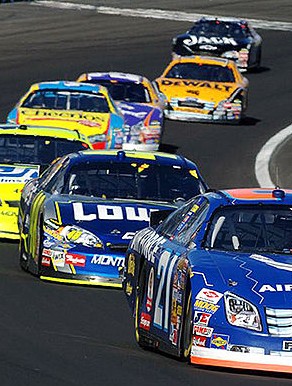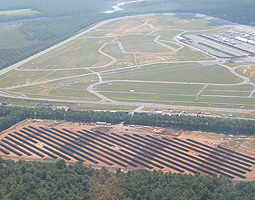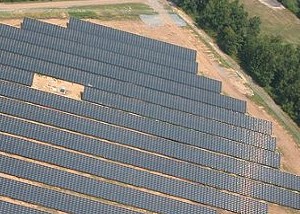
"That headline doesn't feel right." you mutter, scratching your head. After all, you grew up watching those powerful, gas-guzzling monsters thunder through the TV screen. But wrap your mind around this cultural koan at your own risk. Predisposed to nerves? Beware facial tics. Or worse, going fetal.
If you're a Southerner who's disappeared into the Nascar Triangle between the Talladega, Daytona, and Bristol Speedways, you're angry, letting the tri-tip burn on the grill. "Whoa, buddy, don't mess with my lifestyle. Haven't you heard of Junior Johnson. No, then you don't know jack!"

In Entertainment, you are your demographic
Nascar and the environment are a red state/blue state "thing", which is a euphemism for "heedlessly mixing the two can be brand suicide." Trying to finesse the issue, Nascar set up a Department of Green Innovation which recycles racing oil, tires and batteries; plants trees and buys carbon offsets.
But when you take a nostalgic, hyper-masculine brand, a strong environmental taint could kill you. Nascar fears over-greening the sport will cause die-hard fans to go apocalyptic: The Dixie Chicks nursing silent Tesla Roadsters around the track. Cobwebbed grills and dry, empty ice coolers. Richard Petty spinning in his grave. "Hey Thelma, Louise, the canyon's over there; step on it and don't look back."
Change happens at the edges.
Hundreds of miles north of the old Mason-Dixon Line, at the farthest edges of the Nascar universe and less than a year after the ground breaking ceremony at Pennsylvania's Pocono Raceway, a solar energy system is up, running, and

tied to the grid.
The solar farm was constructed on a former parking lot adjacent to the 2.5 mile track by enXco, a renewable energy specialist. The $15 million dollar ground-mount solar farm is made up of 40,000 photovoltaic panels, and generates 3 megawatts of electricity: enough to power the whole racing facility, 1,000 nearby homes, and offset more than 3,200 tons of CO2 a year. According to Autopia:
NASCAR is, of course, quit pleased with itself: "Pocono Raceway's solar energy project is the biggest renewable energy stadium projects in the world by more than two times. It's going to be an awesome achievement, setting a high bar for all facilities throughout sports," said NASCAR green innovation director Dr. Mike Lynch...
Click here to see the CNN report.
The Pocono Raceway officials are not blue-state environmentalists. Adopting

solar was strictly bottom-line. With a $300,000-plus yearly energy bill, state plans to deregulate the power industry threatened to increase the track's rates 40 percent. So Brandon Igdalsky, Pocono Raceway's President, started looking for alternatives.
Building a wind farm was explored and abandoned after realizing the raceway was on the windless side of the hill. After a corporate buying group of local hotels and resorts fell apart, solar was the remaining choice.

Now that the facility has been up and successfully running a few months, Igdalsky points out that 40 percent of the power is sent back to the grid, earning the raceway credits with the local power company. This will help the project pay for itself in five years. He looks to the future:
... the project will last for 40 years, and that's a lot of time for that thing to be sitting there and making power. If we can do our little part not only for what we need, but also for the environment and society as a whole, it's a win-win-win."
A word of caution: if Nascar starts rapidly adopting solar to their traditional, Southern Speedways, rush out and buy rapture insurance.
How soon will Nascar "green" the other Speedways?
Photo: cars on track: US Air Force, Public Domain
Map: Nascar race sites: Rosso Robot Creative Commons
Photo: Pocono Raceway ariel: Nascar Press release
Photo: Pocono solar array: Nascar Press Release
Photo: Pit Stop: US Navy, Public Domain



Comments
The longer I follow NASCAR, the more it seems to be one of the better run professional sport brands. From how it is marketed and the business details are controlled. Especially since almost everything it does walks a fine line with super-modern technology and audience expansion on one side and maintaining the culture and historic aspects of the sport on the other. They have managed to do pretty well - though the bar in other sports may be pretty low. This is another example - while it could be a great PR move used to help deflect criticism of a resource intensive activity, it could also be a smart business decision that will probably save a lot of money but at the very least limit risk. Similar debate as when refineries install wind turbines on their property.
I still think it's no coincidence that the solar track is in Penn-- and not owned by the France family which controls most of the other Nascar tracks. I agree, Nascar is well run but it has run into problems trying to appeal to more traditional, long-term fans and the newer fans brought in over the last 10 years. When they finally make the change, their initial timidity will seem silly in retrospect. DIck Cheney laid down the political markers about energy and conservation years ago, and the France family is still intimidated by that.